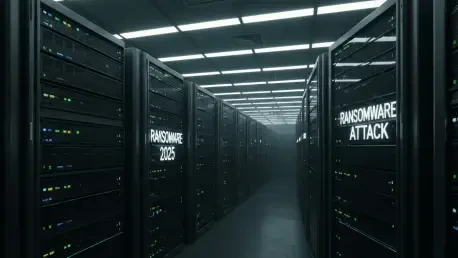In the digital battleground of 2025, ransomware stands as a formidable adversary, with a staggering 47% surge in incidents shaking the foundations of global cybersecurity, painting a vivid picture of a crisis that no business can afford to ignore. As cybercriminals refine their tactics and exploit emerging vulnerabilities, the urgency to understand and combat this technology-driven menace has never been greater. This review delves into the intricate mechanisms of ransomware, evaluates its current impact on industries, and assesses the tools and strategies available to counter its relentless advance.
The Evolution of Ransomware Technology
Ransomware has transformed from a niche threat into a pervasive scourge, largely due to the advent of ransomware-as-a-service (RaaS). This model operates like a sinister subscription service, allowing even novice attackers to access sophisticated tools and launch devastating campaigns with minimal technical expertise. Available on the dark web, RaaS platforms have democratized cybercrime, fueling the dramatic increase in attack frequency and enabling a broader pool of malicious actors to wreak havoc on unsuspecting targets.
Beyond accessibility, the technology behind ransomware has grown more complex, incorporating advanced encryption methods and evasion techniques. Modern strains often target critical systems, locking organizations out of essential data while demanding exorbitant payments. The seamless integration of these tools into coordinated attack frameworks underscores the need for equally advanced defensive technologies to keep pace with this rapidly evolving threat.
Key Features Fueling the Ransomware Surge
The Mechanics of Ransomware-as-a-Service
At the heart of the ransomware epidemic lies the RaaS business model, which operates with chilling efficiency. Cybercriminals can lease ready-made malware kits, complete with customer support and payment processing, lowering the barrier to entry for would-be attackers. This commercialization of cybercrime has directly contributed to the unprecedented spike in incidents, as it equips even low-skill perpetrators with the means to target high-value entities.
The accessibility of RaaS on hidden marketplaces has also led to a proliferation of customized attacks. Operators tailor their services to specific industries or vulnerabilities, ensuring maximum disruption and profitability. This scalability of malicious technology poses a significant challenge for cybersecurity professionals striving to predict and mitigate the next wave of threats.
The Rise of Organized Ransomware Groups
Another critical feature of the current ransomware landscape is the sheer number of active groups, with 66 distinct entities identified in September alone. These organizations exhibit a level of professionalism akin to legitimate enterprises, often recruiting skilled programmers and insiders to enhance their attack precision. Their ability to orchestrate large-scale campaigns sets them apart from earlier, less coordinated threats.
These groups leverage cutting-edge technology to exploit specific weaknesses, such as unpatched software or human error. Their strategic focus on high-impact targets amplifies the damage, making it imperative for businesses to adopt robust monitoring tools and threat intelligence systems to detect and disrupt these operations before they strike.
Emerging Attack Patterns and Vectors
The tactics employed by ransomware operators have evolved to exploit contemporary workplace trends, such as hybrid work environments. Unmanaged devices and remote access points have become prime entry points for attackers seeking to infiltrate networks. This shift in strategy highlights the expanding attack surface that organizations must defend in an era of distributed workforces.
Additionally, the visibility of ransomware incidents on the dark web has surged, with a 31% increase in exposed cases between July and September. This trend indicates not only the growing boldness of cybercriminals but also their reliance on public shaming to pressure victims into paying ransoms. Such developments necessitate advanced detection technologies capable of identifying and neutralizing threats before they escalate.
Industries and Businesses Under Siege
Manufacturing emerges as the most targeted sector, burdened by high downtime costs and reliance on outdated systems. The interconnected nature of supply chains further exacerbates their vulnerability, as a single breach can ripple across multiple partners. This sector’s struggle underscores the critical need for modernized infrastructure and real-time threat response solutions.
Equally at risk are professional, scientific, and technical services, where sensitive data like intellectual property becomes a prime target for extortion. Meanwhile, small and medium-sized businesses (SMBs) with fewer than 200 employees and revenues under $25 million face disproportionate challenges. Limited budgets and inadequate cybersecurity measures often leave them with little choice but to comply with ransom demands, perpetuating the cycle of attacks.
Leading Ransomware Threats in Focus
In the third quarter of the year, specific ransomware groups have risen to prominence, with Qilin maintaining its dominance for two consecutive quarters. Other notable players, including Akira, INC Ransom, Play, and Safepay, have demonstrated remarkable coordination in their operations. Their ability to exploit sector-specific vulnerabilities amplifies the urgency for tailored defense mechanisms.
These groups employ a range of technological innovations, from polymorphic malware that evades detection to sophisticated social engineering tactics. Their strategic planning often targets critical infrastructure, aiming to maximize disruption and financial gain. Countering such threats requires not only updated software but also a cultural shift toward proactive security within organizations.
Challenges in Defending Against Ransomware
One of the most pressing obstacles in combating ransomware lies in technical vulnerabilities, such as unpatched systems that serve as open doors for attackers. Coupled with human errors like falling for phishing scams, these weaknesses create a perfect storm for cybercriminals to exploit. Addressing these gaps demands a combination of automated patch management tools and comprehensive user education.
Beyond internal issues, the expanding attack surface due to remote work and third-party vendor dependencies complicates defense efforts. Many organizations struggle to secure every endpoint, especially when dealing with unmanaged devices. This reality calls for integrated security platforms that provide visibility across all network components and mitigate risks from external partners.
Financial and operational constraints further hinder SMBs, which often lack the resources for robust defenses. The dilemma of paying ransoms versus facing devastating losses creates a vicious cycle, as compliance funds further attacks. Breaking this pattern requires affordable, scalable security solutions tailored to the unique needs of smaller enterprises.
Strategies for Mitigation and Defense
Expert insights emphasize prevention as the cornerstone of ransomware defense, advocating for strong cybersecurity hygiene. Employee training on recognizing phishing attempts and managing passwords effectively can significantly reduce the likelihood of breaches. Implementing multi-factor authentication (MFA) and virtual private networks (VPNs) adds critical layers of protection to vulnerable systems.
Continuous monitoring of security gaps is also essential, particularly as attack vectors evolve with workplace trends. Businesses must invest in tools that provide real-time threat intelligence and automated responses to potential intrusions. Such proactive measures can disrupt ransomware campaigns before they inflict irreparable harm.
Looking ahead, the development of advanced cybersecurity technologies offers hope for countering sophisticated threats. Innovations in artificial intelligence and machine learning could enhance predictive capabilities, identifying risks before they materialize. Staying ahead of cybercriminals will require sustained investment in these cutting-edge solutions over the coming years, from now through 2027 and beyond.
Final Thoughts on the Ransomware Challenge
Reflecting on the comprehensive analysis conducted, it became evident that ransomware had carved a destructive path through the digital landscape by exploiting both technological and human vulnerabilities. The surge in incidents, driven by accessible tools like RaaS and the coordination of numerous active groups, had placed immense pressure on industries like manufacturing and SMBs, exposing critical gaps in their defenses.
As a path forward, organizations were encouraged to prioritize the adoption of integrated security frameworks that encompassed employee training, advanced authentication methods, and real-time monitoring. Collaboration across sectors to share threat intelligence also emerged as a vital step to build collective resilience against future attacks. By investing in scalable solutions and fostering a culture of vigilance, businesses could begin to turn the tide against this pervasive threat, ensuring a more secure digital environment for all stakeholders.









